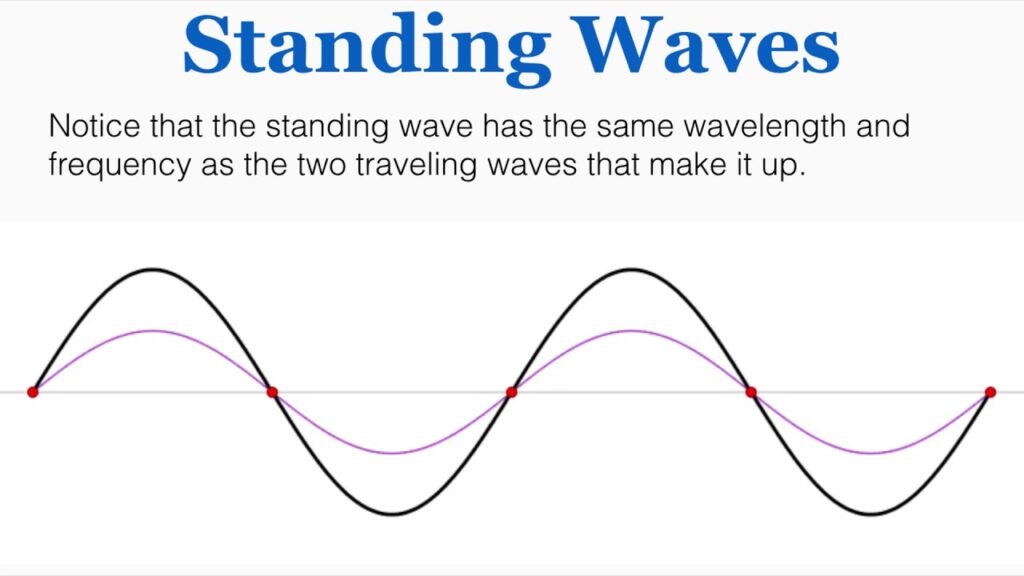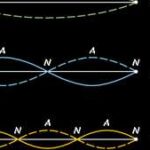Traveling Waves vs. Standing Waves
A mechanical wave is a disturbance that is created by a vibrating object and subsequently travels through a medium from one location to another, transporting energy as it moves. The mechanism by which a mechanical wave propagates itself through a medium involves particle interaction; one  particle applies a push or pull on its adjacent neighbor, causing a displacement of that neighbor from the equilibrium or rest position. As a wave is observed traveling through a medium, a crest is seen moving along from particle to particle. This crest is followed by a trough that is in turn followed by the next crest. In fact, one would observe a distinct wave pattern (in the form of a sine wave) traveling through the medium. This sine wave pattern continues to move in uninterrupted fashion until it encounters another wave along the medium or until it encounters a boundary with another medium. This type of wave pattern that is seen traveling through a medium is sometimes referred to as a traveling wave.
particle applies a push or pull on its adjacent neighbor, causing a displacement of that neighbor from the equilibrium or rest position. As a wave is observed traveling through a medium, a crest is seen moving along from particle to particle. This crest is followed by a trough that is in turn followed by the next crest. In fact, one would observe a distinct wave pattern (in the form of a sine wave) traveling through the medium. This sine wave pattern continues to move in uninterrupted fashion until it encounters another wave along the medium or until it encounters a boundary with another medium. This type of wave pattern that is seen traveling through a medium is sometimes referred to as a traveling wave.
Traveling waves are observed when a wave is not confined to a given space along the medium. The most commonly observed traveling wave is an ocean wave. If a wave is introduced into an elastic cord with its ends held 3 meters apart, it becomes confined in a small region. Such a wave has only 3 meters along which to travel. The wave will quickly reach the end of the cord, reflect and travel back in the opposite direction. Any reflected portion of the wave will then interfere with the portion of the wave incident towards the fixed end. This interference produces a new shape in the medium that seldom resembles the shape of a sine wave. Subsequently, a traveling wave (a repeating pattern that is observed to move through a medium in uninterrupted fashion) is not observed in the cord. Indeed there are traveling waves in the cord; it is just that they are not easily detectable because of their interference with each other. In such instances, rather than observing the pure shape of a sine wave pattern, a rather irregular and non-repeating pattern is produced in the cord that tends to change appearance over time. This irregular looking shape is the result of the interference of an incident sine wave pattern with a reflected sine wave pattern in a rather non-sequenced and untimely manner. Both the incident and reflected wave patterns continue their motion through the medium, meeting up with one another at different locations in different ways. For example, the middle of the cord might experience a crest meeting a half crest; then moments later, a crest meeting a quarter trough; then moments later, a three-quarters crest meeting a one-fifth trough, etc. This interference leads to a very irregular and non-repeating motion of the medium. The appearance of an actual wave pattern is difficult to detect amidst the irregular motions of the individual particles.
What is a Standing Wave Pattern?
It is however possible to have a wave confined to a given space in a medium and still produce a regular wave pattern that is readily discernible amidst the motion of the medium. For instance, if an elastic rope is held end-to-end and vibrated at just the right frequency, a wave pattern would be produced that assumes the shape of a sine wave and is seen to change over time. The wave pattern is only produced when one end of the rope is vibrated at just the right frequency. When the proper frequency is used, the interference of the incident wave and the reflected wave occur in such a manner that there are specific points along the medium that appear to be standing still. Because the observed wave pattern is characterized by points that appear to be standing still, the pattern is often called a standing wave pattern. There are other points along the medium whose displacement changes over time, but in a regular manner. These points vibrate back and forth from a positive displacement to a negative displacement; the vibrations occur at regular time intervals such that the motion of the medium is regular and repeating. A pattern is readily observable.
 The diagram at the right depicts a standing wave pattern in a medium. A snapshot of the medium over time is depicted using various colors. Note that point A on the medium moves from a maximum positive to a maximum negative displacement over time. The diagram only shows one-half cycle of the motion of the standing wave pattern. The motion would continue and persist, with point A returning to the same maximum positive displacement and then continuing its back-and-forth vibration between the up to the down position. Note that point B on the medium is a point that never moves. Point B is a point of no displacement. Such points are known as nodes and will be discussed in more detail later in this lesson. The standing wave pattern that is shown at the right is just one of many different patterns that could be produced within the rope. Other patterns will be discussed later in the lesson.
The diagram at the right depicts a standing wave pattern in a medium. A snapshot of the medium over time is depicted using various colors. Note that point A on the medium moves from a maximum positive to a maximum negative displacement over time. The diagram only shows one-half cycle of the motion of the standing wave pattern. The motion would continue and persist, with point A returning to the same maximum positive displacement and then continuing its back-and-forth vibration between the up to the down position. Note that point B on the medium is a point that never moves. Point B is a point of no displacement. Such points are known as nodes and will be discussed in more detail later in this lesson. The standing wave pattern that is shown at the right is just one of many different patterns that could be produced within the rope. Other patterns will be discussed later in the lesson.


